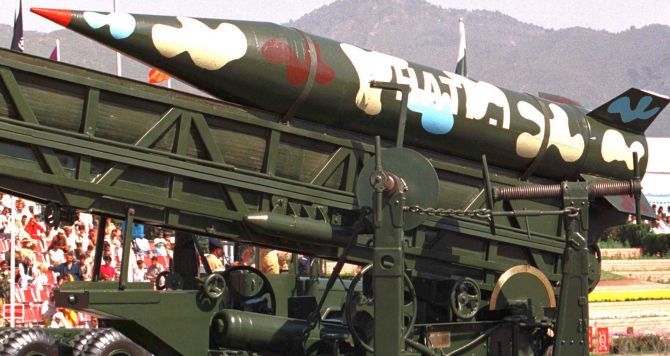Pakistan has a stockpile of approximately 170 nuclear warheads which could realistically grow to around 200 by 2025 at the current growth rate, according to top American atomic scientists.

"We estimate that Pakistan now has a nuclear weapons stockpile of approximately 170 warheads. The US Defense Intelligence Agency projected in 1999 that Pakistan would have 60 to 80 warheads by 2020, but several new weapon systems have been fielded and developed since then, which leads us to a higher estimate,” the Nuclear Notebook column published in the Bulletin of the Atomic Scientists on September 11 said.
The Nuclear Notebook is researched and written by the staff of the Federation of American Scientists' Nuclear Information's Project Director Hans M Kristensen, senior research fellow Matt Korda, and research associate Eliana Johns. The Nuclear Notebook column has been published in the Bulletin of the Atomic Scientists since 1987.
"Our estimate comes with considerable uncertainty because neither Pakistan nor other countries publish much information about the Pakistani nuclear arsenal,” the scientists said.
Given the absence of reliable data originating from within Pakistan, the Nuclear Notebook used a combination of open-source materials to arrive at their estimates and carry out the analysis. Their sources included State-originating data (eg, government statements, declassified documents, budgetary information, military parades, and treaty disclosure data) and non-State-originating data (eg, media reports, think tank analysis, and industry publications). Interestingly, they also extensively used commercial satellite imagery.
"Each one of these sources provides different and limited information that is subject to varying degrees of uncertainty. We cross-checked each data point by using multiple sources and supplementing them with private conversations with officials whenever possible,” the trio said.
With several new delivery systems in development, four plutonium production reactors, and an expanding uranium enrichment infrastructure, Pakistan's stockpile has the potential to increase further over the next several years, the Nuclear Notebook said.
"The size of this projected increase will depend on several factors, including how many nuclear-capable launchers Pakistan plans to deploy, how its nuclear strategy evolves, and how much the Indian nuclear arsenal grows. We estimate that the country's stockpile could potentially grow to around 200 warheads by the late 2020s, at the current growth rate,” the scientists said.
"But unless India significantly expands its arsenal or further builds up its conventional forces, it seems reasonable to expect that Pakistan's nuclear arsenal will not continue to grow indefinitely but might begin to level off as its current weapons programmes are completed,” they added.
Even when the document listed fissile materials production and inventory from available sources in the public domain, the scientists put out a disclaimer: ’Calc'ulating stockpile size based solely on fissile material inventory is an incomplete methodology that tends to overestimate the likely number of nuclear warheads.’
”We estimate that Pakistan currently is producing sufficient fissile material to build 14 to 27 new warheads per year, although we estimate that the actual warhead increase in the stockpile probably averages around 5 to 10 warheads per year,” they further said.
Dwelling in detail on the subject of nuclear-capable aircraft and air-delivered weapons, the Nuclear Notebook listed 36 Mirage III/IV and JF17s. Similarly, it also mentioned details about six currently operational nuclear-capable, solid-fuel, road-mobile ballistic missile systems under the land-based ballistic missiles category -- the short-range Abdali (Hatf-2), Ghaznavi (Hatf-3), Shaheen-I/A (Hatf-4), and Nasr (Hatf-9), and the medium-range Ghauri (Hatf-5) and Shaheen-II (Hatf-6).
Commenting on the 2017's medium-range ballistic missile called Ababeel that Pakistan said is ”capable of carrying multiple warheads, using multiple independent re-entry vehicle (MIRV) technology,” the Nuclear Notebook observed, ”Development of multiple-warhead capability appears to be intended as a countermeasure against India's planned ballistic missile defense system. Its status remains unclear as of July 2023.”
Pointing out that the total number and location of Pakistan's nuclear-capable missile bases and facilities remains unknown, the document said, "Analysis of commercial satellite imagery suggests that Pakistan maintains at least five missile bases that could serve a role in Pakistan's nuclear forces.” It then went on to list the bases with its coordinates and other details, including satellite images: Akro Garrison, Gujranwala Garrison, Khuzdar Garrison, Pano Aqil Garrison and Sargodha Garrison.
Stating how Pakistan's family of ground- and sea-launched cruise missiles is ”undergoing significant development with work on several types and modifications,” the Nuclear Notebook listed details of Babur (Hatf-7) with Babur 1 and Babur 1A, Babur 2 or Babur 1B GLCM, Babur 3 and an under-development variant known as the Harbah.
Admitting that little is publicly known about warhead production, the scientists said: ”But experts have suspected for many years that the Pakistan ordnance factories near Wah, northwest of Islamabad, serve a role. One of the Wah factories is located near a unique facility with six earth-covered bunkers (igloos) inside a multi-layered safety perimeter with armed guards.”











 © 2025
© 2025